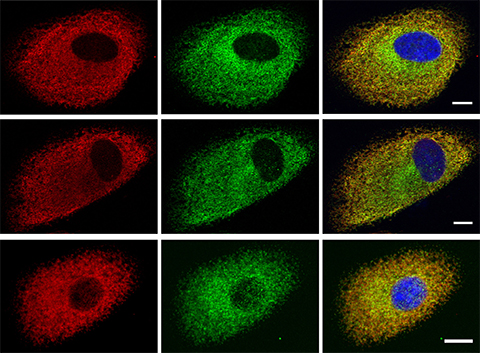ELOVL4 mutations: Two sides of the same coin
Fatty acids constitute cellular membranes, fuel energy production and act as signaling molecules. Long-chain fatty acids have tails of 13 to 21 carbons. The enzymes known as ELOVLs — short for “elongation of very long” — can extend these tails to make them into very long-chain saturated and very long-chain unsaturated fatty acids, known respectively as VLC-SFAs and VLC-PUFAs. Defects in the elongation of fatty acids can cause neuronal, ocular and skin problems.

Martin-Paul Agbaga, an assistant professor of cell biology and ophthalmology at the University of Oklahoma Health Sciences Center, studies the intersection between very long-chain fatty acids and human disease. In a recent publication in the Journal of Lipid Research, Agbaga and his team, which included Yeboah Kofi Gyening, described the mechanisms by which specific ELOVL4 mutations affect particular tissues.
“We are trying to figure out why some patients with ELOVL4 mutations only have retinal dysfunction, some only have brain dysfunction, and some only have skin dysfunction,” Gyening, a recent Ph.D. graduate, said. “We are basically asking why the same mutation is causing such diverse phenotypes.”
The team studied how two ELOVL4 mutants, one associated with brain disorders and the other with skin disease in humans, elongate a precursor fatty acid. They found that both these mutations had some limited capacity to elongate PUFA precursors to VLC-PUFA but blunted the enzyme’s capability to biosynthesize VLC-SFAs.
The question of how the same ELOVL4 can synthesize different VLCFAs in different tissues remains unanswered. “You can get some clues from fish,” Gyening explained. “Some fish species have two different ELOVL4 isoforms: ELOVL4a, which is more active in elongating VLC-SFAs, and ELOVL4b, which prefers VLC-PUFAs. Something similar could happen in humans, but we don’t know yet.”
In normal tissue, ELOVL4 is found in a cell’s endoplasmic reticulum, or ER, but these authors also found it in the nuclear fraction.
The team wondered whether ELOVL4-related disease results solely from a decline in certain VLC-SFAs or if mutated protein within the cells also plays a role. “We did some experiments that indicate that ELOVL4 mutants can induce ER stress,” Gyening said, “which could explain cell death observed in the cerebellum of some patients.”
These findings also could help determine treatment for patients with ELOVL4 deficiency. “In the lab, we were able to artificially synthesize VLCFAs to incorporate into the diet of rodents carrying ELOVL4 mutations, resulting in a partial rescue of the phenotype,” Gyening said. “Because we know which VLCFAs go down with the different ELOVL mutations, we could recommend personalized dietary supplementations as part of the treatment.”
Enjoy reading ASBMB Today?
Become a member to receive the print edition four times a year and the digital edition monthly.
Learn moreGet the latest from ASBMB Today
Enter your email address, and we’ll send you a weekly email with recent articles, interviews and more.
Latest in Science
Science highlights or most popular articles

Fueling healthier aging, connecting metabolism stress and time
Biochemist Melanie McReynolds investigates how metabolism and stress shape the aging process. Her research on NAD+, a molecule central to cellular energy, reveals how maintaining its balance could promote healthier, longer lives.

Mapping proteins, one side chain at a time
Roland Dunbrack Jr. will receive the ASBMB DeLano Award for Computational Biosciences at the ASBMB Annual Meeting, March 7–10, just outside of Washington, D.C.

Exploring the link between lipids and longevity
Meng Wang will present her work on metabolism and aging at the ASBMB Annual Meeting, March 7-10, just outside of Washington, D.C.

Defining a ‘crucial gatekeeper’ of lipid metabolism
George Carman receives the Herbert Tabor Research Award at the ASBMB Annual Meeting, March 7–10, just outside of Washington, D.C.

The science of staying strong
Muscles power every movement, but they also tell the story of aging itself. Scientists are uncovering how strength fades, why some species resist it and what lifestyle and molecular clues could help preserve muscle health for life.

Bacteriophage protein could make queso fresco safer
Researchers characterized the structure and function of PlyP100, a bacteriophage protein that shows promise as a food-safe antimicrobial for preventing Listeria monocytogenes growth in fresh cheeses.

